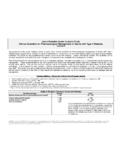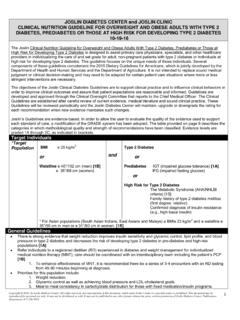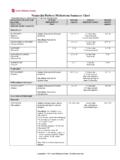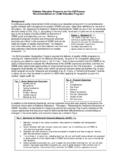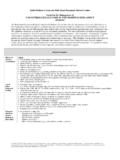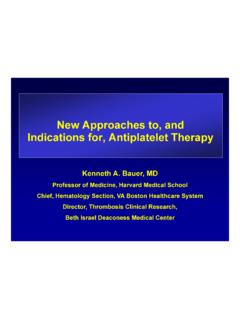Transcription of JOSLIN DIABETES CENTER & JOSLIN CLINIC …
1 1/27 Copyright 2017 by JOSLIN DIABETES CENTER . All rights reserved. Any reproduction of this document which omits JOSLIN s name or copyright notice is prohibited. This document may be reproduced for personal use only. It may not be distributed or sold. It may not be published in any other format without the prior, written permission of JOSLIN DIABETES CENTER , Publications Department, 617-309-5815. JOSLIN DIABETES CENTER & JOSLIN CLINIC CLINICAL GUIDELINE FOR ADULTS WITH DIABETES Rev. 05/17/17 The JOSLIN Clinical Guideline for Adults with DIABETES is designed to assist primary care physicians and specialists individualize the care of and set goals for non-pregnant adults with DIABETES . This Guideline focuses on the unique needs of the patient with DIABETES . It is not intended to replace sound medical judgment or clinical decision-making and may need to be adapted for certain patient care situations where more or less stringent interventions may be necessary.
2 The objectives of the JOSLIN Clinical DIABETES Guidelines are to support clinical practice and to influence clinical behaviors in order to improve clinical outcomes and assure that patient expectations are reasonable and informed. Guidelines are developed and approved through the Clinical Oversight Committee that reports to the Medical Director of JOSLIN DIABETES CENTER . The Clinical Guidelines are established after careful review of current evidence, medical literature and sound clinical practice. This Guideline will be reviewed periodically and modified as clinical practice evolves and medical evidence suggests. (Additional Guidelines are available ) JOSLIN s Guidelines are evidence-based. A modification of the GRADE system has been adopted to enable the user an evaluation of the evidence used to support each standard of care. The table provided on page 13 describes the categories in which methodological quality and strength of recommendations have been classified.
3 Evidence levels are graded 1A through 2C, as indicated in brackets. Where evidence is not graded, recommendations are made based on the expertise of the Clinical Oversight Committee Table of contents Section Page ( ) Approach to Care ( ) Individualizing patient care ( ) The patient-centered approach ( ) Working in a team ( ) Frequency of medical visits 2 ( ) Diagnosis ( ) General criteria for diagnosis ( ) Hemoglobin A1C ( ) Goals ( ) Caveats ( ) Monitoring ( ) Treatment 3 ( ) Self-Monitoring of Blood Glucose ( ) Goals ( ) Frequency ( ) Post-prandial monitoring ( ) Using alternative sites to monitor ( ) Continuous glucose monitoring 4 ( ) Hypoglycemia ( ) Classification ( ) Treatment ( ) Education 5 ( ) DIABETES Self-Management Education and Support 6 ( ) Medical Nutrition Therapy 6 ( ) Physical Activity 6 2/27 Copyright 2017 by JOSLIN DIABETES CENTER . All rights reserved.
4 Any reproduction of this document which omits JOSLIN s name or copyright notice is prohibited. This document may be reproduced for personal use only. It may not be distributed or sold. It may not be published in any other format without the prior, written permission of JOSLIN DIABETES CENTER , Publications Department, 617-309-5815. ( ) Physical activity for healthy adults ( ) Physical activity for adults with medical or physical limitations ( ) Cardiovascular health ( ) Anti-platelet therapy ( ) Other therapeutic considerations ( ) When to conduct a stress test ( ) Lipid management ( ) Screening for lipid disorders ( ) Treatment ( ) Blood pressure management ( ) Blood pressure measurement ( ) Blood pressure targets ( ) Treatment 7 ( ) Renal Health ( ) Screening for renal disease ( ) Treatment 9 ( ) Ocular Health ( ) Screening for eye disease ( ) Treatment 10 ( ) Nervous system health ( ) Screening for neuropathy ( ) Methods ( ) Frequency ( ) Treatment 10 ( ) Foot Health ( ) Screening for foot disease ( ) Methods ( ) Frequency ( ) Treatment ( ) Foot care training 11 ( ) Oral health 12 ( ) Behavioral health 12 ( ) Women s health 12 ( ) Men s health 12 ( ) Additional considerations ( )
5 Identifying sleep disorders ( ) Tobacco dependence ( ) Immunizations 13 List of abbreviations 14 Grading System 16 References 17 ( ) APPROACH TO CARE ( ) Individualizing patient care: The needs and goals of each patient are unique. Developing a treatment plan based on a thorough assessment which includes an understanding of not only the patient s medical needs, but also other factors that may influence the treatment plan such as social history, race, cultural issues, ethnicity, education needs (including literacy and numeracy), comorbidities and barriers to care is essential. The patient s treatment plan should identify medical treatment, educational 3/27 Copyright 2017 by JOSLIN DIABETES CENTER . All rights reserved. Any reproduction of this document which omits JOSLIN s name or copyright notice is prohibited. This document may be reproduced for personal use only. It may not be distributed or sold.
6 It may not be published in any other format without the prior, written permission of JOSLIN DIABETES CENTER , Publications Department, 617-309-5815. interventions, follow-up, and ongoing support. Use of the electronic medical record may help to facilitate care, by enabling the team to track progress, ensuring goals are met, and communication flows between team members and the patient. ( ) The patient-centered approach: DIABETES is a condition that requires self-management. A collaborative counseling model (where the patient is involved in decisions and goal setting) helps promote behavior change. Whenever appropriate, with the patient s consent, involve family members and caregivers in medical visits and education. ( ) Working in a team: DIABETES is best managed by a team which may include clinicians, DIABETES educators, and dieticians. The patient should be informed, and fully aware of the roles the various team members play.
7 If access to a team is not possible within the office practice, it is useful to identify community resources. Clear communication between all providers is critical to ensure patients needs are being met. ( ) Frequency of medical visits: While the frequency of visits for ongoing care should be individualized, monitoring progress of the patient through medical visits is recommended at least 2-4 visits/year. Special attention should be given to patients who do not keep scheduled appointments, have frequent hospitalizations or miss days of work/school. Since many factors contribute to the patient s ability to manage their care, the provider should: Engage patients in identifying and resolving contributing factors or barriers to under-utilization or over-utilization of healthcare services. Patients with challenging care may benefit from consultation with Endocrinologists focused on DIABETES care.
8 For further information on when to refer patients, please refer to: Guidelines for specialty consultation/referral ( (1).pdf) Refer to a DIABETES educator (DE), registered dietician, social service or behavioral health professional to address possible barriers and/or psychosocial issues Establish a process of follow-up communication regarding adherence to the treatment plan and sustaining behaviors. ( ) DIAGNOSIS OF DIABETES MELLITUS ( ) General criteria for diagnosis: The diagnosis of DIABETES mellitus can be made based upon: Random plasma glucose > 200 mg/dl ( mmol/L) and symptoms of DIABETES (polyuria, polydipsia, ketoacidosis, or unexplained weight loss) OR Fasting plasma glucose (FPG)* >126 mg/dl ( mmol/L) OR Results of a 2-hour 75-g Oral Glucose Tolerance Test (OGTT)* > 200 mg/dl ( mmol/L) OR Glycated hemoglobin* (A1C) > (46 mmol/mol) ** * These tests should be confirmed by a repeat test, on a different day, unless unequivocally high **A glycated hemoglobin (A1C) level of or higher on 2 separate days is acceptable for diagnosis of DIABETES .
9 [1B]. However, some individuals may have an A1C < with DIABETES diagnosed by previously established blood glucose criteria. Therefore, presence of either criterion is acceptable for diagnosis. Those with an A1C of (39-46 mmol/mol) are considered to have pre- DIABETES have a high risk for developing DIABETES . These patients should be treated with lifestyle changes and followed more frequently. The A1C should be performed in a laboratory using a method that is National Glycohemoglobin Standardization Program (NGSP) certified and standardized to the DIABETES Control and Complications Trial (DCCT) assay. A point of care (POC) A1C is not acceptable for diagnosis of DIABETES . ( ) Hemoglobin A1C Diagnosis: See above section on Diagnosis of DIABETES Mellitus ( ) Goals: A1C target goal should be individualized for each patient. A goal of < 7%(53 mmol/mol) is chosen as a practical level for most patients to reduce the risk of long term complications of DIABETES .
10 Achieving this goal is recommended if it can be done safely, and practically. [1B] Alternative A1C goals may be set based upon presence or absence of microvascular and/or cardiovascular complications, hypoglycemic unawareness, cognitive status and life expectancy. [1A] For patients with longstanding type 2 DIABETES with pre-existing CVD, or 4/27 Copyright 2017 by JOSLIN DIABETES CENTER . All rights reserved. Any reproduction of this document which omits JOSLIN s name or copyright notice is prohibited. This document may be reproduced for personal use only. It may not be distributed or sold. It may not be published in any other format without the prior, written permission of JOSLIN DIABETES CENTER , Publications Department, 617-309-5815. high CAD risk ( DIABETES plus two or more additional risk factors), consider revising A1C goals to avoid adverse consequences of tight glycemic control hypoglycemia.

